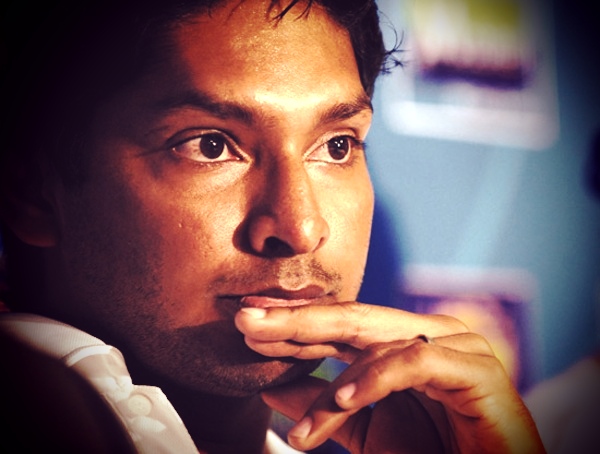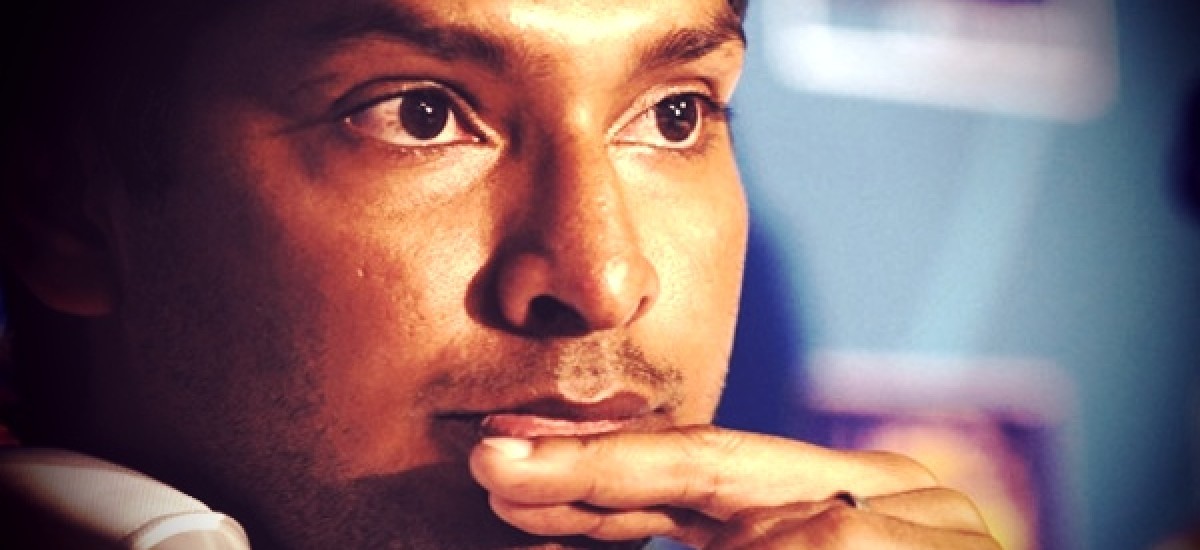
Kumar Sangakkara’s Spirit of Cricket Cowdrey Lecture for the MCC this summer was the antithesis of that presented within the same portals in 2006 by Martin Crowe.[i] Where Crowe returned to the medieval archaic within the field of cricket and displayed the sentiments of a caveman, Sangakkara was forward-looking and stepped boldly beyond the confines of cricket to the socio-political dispensation in Sri Lanka.
In doing so Sangakkara broke the code of conduct enjoined on him by his contract with Sri Lanka Cricket. He was therefore intrepid. This was boldness in a good cause, the greater cause of the cricketing order in Sri Lanka (and beyond) on the one hand and, on the other, the vital cause of reconciliation across the fractured political formation in Sri Lanka.
There are missing dimensions and some sweeping comments in his survey of Sri Lanka’s cricketing history in the last twenty years that call for caveats, issues that I will address separately elsewhere. The focus here is directed towards his erudite and passionate venture into the field of Sri Lankan politics and his insistence that the cricketing arena provides one path towards ethnic reconciliation.
He and his wife Yehali had already ventured on this path: first, when they joined Muralitharan and others in the work of tsunami relief across the breadth of the island in early 2005; and, more recently, in April immediately after the World Cup, when both of them visited St. Patrick’s College in Jaffna town and were feted there. The latter event was not widely publicized as far as I know. It was pure fortune that I received a set of photographs illustrating the visit from an old Trinitian, Sangakkara’s alma mater.[ii] This felicitous and symbolic move towards ethnic amity gains in significance from two little facts: (1) the visit was not to Trinity’s ‘natural partner’, the Anglican venture, St. John’s College, but to a Catholic school; and (2) Kumar was accompanied by Yehali (though, for obvious reasons, their twins did not join them at the school).
Peter Roebuck has gone so far as to assert that Sangakkara’s presentation was “the most important speech in cricket history.” Deploying his awareness of the Sangakkara visit to Jaffna, he then went on to state that “only those with empires to protect will resent his words. Only those blighted with the curse of nationalism will deny him his voice. He spoke as a patriot, a higher calling altogether.”[iii]
Thus, Roebuck drew a distinction between the concepts of “nationalism” and “patriotism.” I welcome the direction he is pointing towards, but have grave doubts whether this differentiation will be understood by many readers. It is a difficult distinction to sustain when the two concepts overlap and when ultra-patriots can be much as much a virus as ultra-nationalists. After all, the Sinhala ultras include those who bear the badge of dēsa prēmi (those who love their country, namely “patriots”) boldly on their foreheads.
For this reason I prefer to move in the same direction and laud Sangakkara’s speech as the profound expression of an ecumenical nationalist. What can be more ecumenical than the stirring lines with which he concluded his classic peroration: “Fans of different races, castes, ethnicities and religions who together celebrate their diversity by uniting for a common national cause. They are my foundation, they are my family. I will play my cricket for them. Their spirit is the true spirit of cricket. With me are all my people. I am Tamil, Sinhalese, Muslim and Burgher. I am a Buddhist, a Hindu, a follower of Islam and Christianity. I am today, and always, proudly Sri Lankan.”[iv]
In this presentation of self, Sangakkara subsumed his being as a Trinitian, a radala Govigama, a Kandyan and a Sinhalese within the encompassing identity of being a Sri Lankan, a multi-ethnic and multi-religious collective being. This sentiment, this understanding, I call an ecumenical being, the ecumenical Lankan.
Forerunners and Pathfinders
Some 160 years before, at the point when the British colonial dispensation was bustling forward in capitalist growth, a small group of young “Ceylonese” (as they were known then) stepped forward in the same erudite and ecumenical spirit as young Sangakkara. Inspired by the literary currents of European romanticism as well as the political currents of nationalism,[v] these men – and at least one woman, Eleanor Lorenz (nee Nell) – started a journal called Young Ceylon in 1850 and sustained it till September 1852.
These young men were mostly educated at the Colombo Academy, which later transformed into the prestigious Royal College. The key personnel were Charles Ambrose Lorenz, Frederick Nell and Louis Nell, all from the Burgher middle class in the emerging town of Colombo. They were assisted by Charles Ferdinands, John Prins, Dandris de Silva Gooneratne, James de Alwis, T. A. Pierez, Edward Kelaart and others. Their choice of title was obviously drawn from the “Young Italy” movement associated with Mazzini and the Italian Risorgimento as well as the Young England movement associated with the young Benjamin Disraeli.[vi]
Young Ceylon dedicated itself “to the spirit of inquiry which [it regarded] as the distinguishing feature of the present age.” Its editors chose as its motto the lines from the German Romantic Ludwig Tieck’s dedication to a fellow man-of-letters, Schlegel: “Wir für Kunst und Wissenschaft vereignigt lebten, und une in mannigfalten Bestrebungen begegneten” – We live united for Art and Knowledge, and emulate one another in various competitions (emphasis theirs).
As critically, some few years later, some of these personnel mustered the capital to purchase the Examiner, one of the existing bi-weekly English newspapers owned by an Englishman, the lawyer John Selby. They formed a syndicate for the purpose and it is of some consequence that three Sinhalese lawyer friends, James A. Dunuwille, James de Alwis and Harry Dias were among those who invested money in the enterprise.[vii]
It would be wrong to treat this little circle as an elitist cluster with no links with the lower strata of society and the indigenous vernacular. In 1862 they offered guidance to the Sinhalese personnel who launched the Lakminipahana, the first newspaper printed in the Sinhala language.[viii] CA Lorenz himself was something of a folk-hero in the Colombo locality so that at least one or two working-class families christened their young boys with his name.
Set thus in their context, it is of central implication for the thesis voiced here on ecumenical nationalism that the raison d’etre of the Young Ceylon circle was a sturdy resistance to the colonial airs of superiority displayed by the dominant British ruling class. This was quite clear in the anti-colonial motifs inscribed within a pamphlet penned in 1853 by the pseudonymous “Henry Candidus” (probably Lorenz) under the title A Desultory Conversation between Two Young Aristocratic Ceylonese (Colombo, The Examiner Press).[ix] These leanings were then embodied and disseminated in the subsequent outpourings in the Examiner newspaper from 1859 onwards.[x] In a private letter Lorenz clarified the goals of this early act of Ceylonese nationalism through reportage: “we shall prove that Ceylon after all has arrived at a position when her children can speak for themselves; and that in doing so they can exercise the moderation which even English journalists have failed to observe” (letter to Richard Morgan, 14 March 1859).[xi]
Here, then, were the first Ceylonese nationalists standing tall in questioning aspects of British rule, albeit constrained from calling for the eviction of the British because of the pragmatic limits arising from the circumstances of their time. It was from within this context and from the nomenclature adopted for the island peoples that, in my conjecture, a new adjective was introduced into the Sinhala lexicon as a translation of the adjectival “Ceylonese,” namely, the term “lānkika” – denoting a person of and from Ceylon.[xii]
Charles Ambrose Lorenz and Kumar Sangakkara, therefore, straddle several centuries in standing forth as ecumenical Ceylonese/Lankan nationalists. The term “ecumenical,” of course, has a Christian ring to it and refers to forms of Christian worship that are interfaith and non-denominational. It is a word that has such synonyms as “comprehensive,” “inclusive” and “cosmopolitan.” To broaden its import for those unfamiliar with this Christianized vocabulary, let me bring in an Asian figure who sustains the same image. I refer to the Mauryan Emperor of the third century BCE, Asoka. He may be widely known to Sri Lankans as the cakravarti figure who introduced the Buddha Dhamma to Siri Laka or Heladiv. However, in my understanding, with all the limitations of one who is a not a historian of ancient times, I believe that Asoka’s religious philosophy was a tolerant one that allowed for diversity and embraced all forms of religiosity under one parasol.[xiii] He became the epitome of the Asian ecumene.
Note, however, that he moved to such a position only after the cataclysmic and gory War of Kalinga. It was a perspective born out of suffering. Since Sri Lanka has been through several horrendous wars in recent times, the story of Asoka and his new-found compassion and tolerant encompassing political philosophy is a good moral to link with the ecumenical sentiments in which Kumar Sangakkara was nurtured from his childhood.
I conclude, therefore, with an emphasis on the worth of an ecumenical Asokan nationalism for Sri Lanka as it stands today. This is the approach and the foundation required for the massive tasks of re-building and reconciliation we Sri Lankans face in the immediate future. It is not retribution, “truth” or “justice,” nor the thamil-wolf of retribution posing in the sheep’s clothing of truth & justice that is the need of the hour. It is, to repeat, the spirit and substance of an ecumenical Asokan Lankan that is the paramount requirement NOW.
[i] See http://www.lords.org/latest-news/news-archive/the-2006-cowdrey-lecture-full-text,726,NS.html and Roberts, Incursions & Excursions in and around Sri Lankan Cricket, Colombo, 2011, chap. 4.
[ii] See http://thuppahi.wordpress.com/2011/04/12/sangakkaras-visit-st-patricks-college-jaffna/
[iii] Roebuck, “Sangakkara’s challenge to cricket,” ”http://www.espncricinfo.com/magazine/content/story/ 522022.html.
[iv] Extract from Cowdrey Lecture in http://thuppahi.wordpress.com/2011/07/09/kumar-sangakkara%e2%80%99s-ecumenical-lankan-nationalism/.
[v] Message: “note this Peter.”
[vi] Fuller details can be found in Michael Roberts, Ismeth Raheem & Percy Colin-Thomé, People Inbetween. The Burghers and the Middle Class in the Transformations within Sri Lanka, 1790s-1960s, Colombo, Sarvodaya Book Publishing Services, Ratmalana, 1989. ISBN 955-599-013-1. There are several photographs that depict the leading members of this group as well as the facsimile pages of Young Ceylon.
[vii] Roberts, People Inbetween, pp. 158-59.
[viii] Roberts, People Inbetween, pp. 79-80. Lakminipahana was a fortnightly paper and the first edition appeared on 11th September 1862. Gallewas their centre of operations and the key figures were Walanē Sri Siddhārtha Thēra, Gunatilaka Atapattu Mudalitumā, Koggalē Johannes Pandithilaka, Pundit Batuwantudāwe, and Don Andris de Silva.
[ix] Roberts, People Inbetween, pp. 71-74, 79,8, 82, 155-58, 168, 172. This article is reproduced in Michael Roberts, Sri Lanka: Collective Identities Revisited, Vol II, Colombo Marga Publications, 1998, chapter 1.
[x] This newspaper was subsequently renamed the Ceylon Examiner.
[xi] Roberts, People Inbetween, pp. 158-59.
[xii] During my researches on the ideology of the independent state of Sīhalē (the Kandyan Kingdom) in the 17th and 18th centuries I never came across the term lānkika. However, I did not read all the literature and this is an issue for Sinhala specialists of that era. The words I came across were ratun (and its variants), jātiya, dana, danun, jana, senaga and minissu – many used in the sense “people” and requiring an adjectival collective name before it. See Roberts, Sinhala Consciousness in the Kandyan Period, 1590s to 1815, Colombo, Vijitha Yapa Publications, 2004, pp. 104-08.
[xiii] British readers who are unfamiliar with this major historical figure should think back to the BBC documentary produced by Peter Wood. Or they could just google “Asoka Mauraya.”

